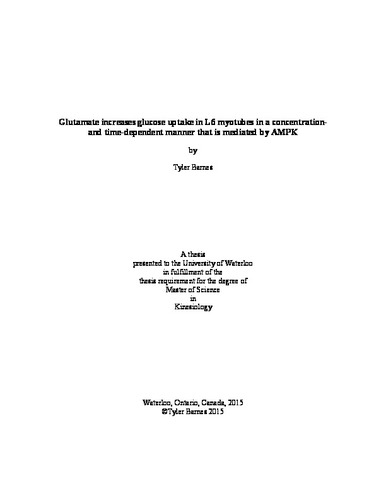| dc.description.abstract | The majority of studies that have examined the interactions between glutamate, insulin and glucose are in vivo and have focused on the insulin response that is elicited when glutamate is elevated in circulation or in a given tissue. Few studies have investigated the effects of glutamate on glucose uptake and handling. Work from our lab suggests that monosodium glutamate ingestion in humans can attenuate rises in blood glucose following a carbohydrate load (75g of Trutol®) compared with administration of a carbohydrate load alone (DiSebastiano et al., 2013); this improvement in glucose handling occurred in absence of changes in serum insulin concentrations. However, the mechanisms responsible for this observation have yet to be investigated. Considering that glutamate is the primary amino acid taken up by the muscle (Graham & MacLean, 1998; Graham et al., 1997) and skeletal muscle is responsible for approximately 85% of whole-body glucose disposal (DeFronzo et al., 1981), this study examined the isolated effects of glutamate on glucose uptake in skeletal muscle to better understand the glucose response that has been observed in vivo as a result of glutamate supplementation. The objectives were to: 1) examine the effects of glutamate on glucose uptake in isolated L6 myotubes in a dose and time dependant manner, 2) measure and compare glucose uptake with the provision of leucine and insulin, and 3) investigate and compare the primary mechanisms of glucose handling in skeletal muscle cells in each experimental condition. Differentiated L6 rat muscle cells were treated with increasing doses of glutamate for 1 hr and glucose uptake was assessed by the addition of [3H]-2-Deoxyglucose in HBS for 10 min. Cells treated with 500µM, 1mM, and 2mM significantly increased [3H]-2-DG uptake to 129 ± 7%, 123 ± 5%, and 121 ± 4%, respectively relative to the control condition (P<0.05). To evaluate the effect of incubation time on glucose uptake, cells were treated with 2mM of glutamate for various times ranging from 0 to 120 minutes. Cells treated for 30 minutes resulted in the greatest increase in [3H]-2-DG uptake versus the control condition (143 ± 9%, P<0.001), while cells treated for 45 and 60 minutes also significantly increased [3H]-2-DG uptake (125 ± 9% and 129 ± 7% relative to the control, respectively; P<0.05). To measure and compare the magnitude of glucose uptake elicited by glutamate to other known stimulators of uptake, cells were treated with leucine, insulin, and a combination of GLU+LEU and GLU+INS. Each treatment significantly elevated [3H]-2-DG uptake relative to the control condition (126 ± 9%, 141 ± 12%, 148 ± 3%, and 148 ± 3%, respectively; P<0.05). To investigate the primary mechanisms by which glutamate acts to increase glucose uptake, cells were treated with 2mM of glutamate, leucine, or insulin for 30 minutes with a PI3K inhibitor (LY294002), PKC inhibitor (BMD I), or AMPK inhibitor (Compound C). Compound C and BMD1 reduced glucose uptake in cells treated with glutamate to a magnitude that was similar to that of the control condition (98 ± 2% and 103 ± 4%, respectively; P<0.05), whereas cells treated with LY294002 showed significantly greater uptake relative to the control (128 ± 5%, P<0.05). In contrast, [3H]-2-DG was blocked in cells treated with leucine or insulin in combination with LY294002. The results from this study suggest that glutamate can increase glucose uptake into L6 myotubes in a dose- and time- dependent manner that is similar in magnitude to leucine and insulin, mediated by AMPK and PKC. This study will provide a basis for future animal and human studies exploring the interactions of glutamate and glucose in skeletal muscle. | en |

